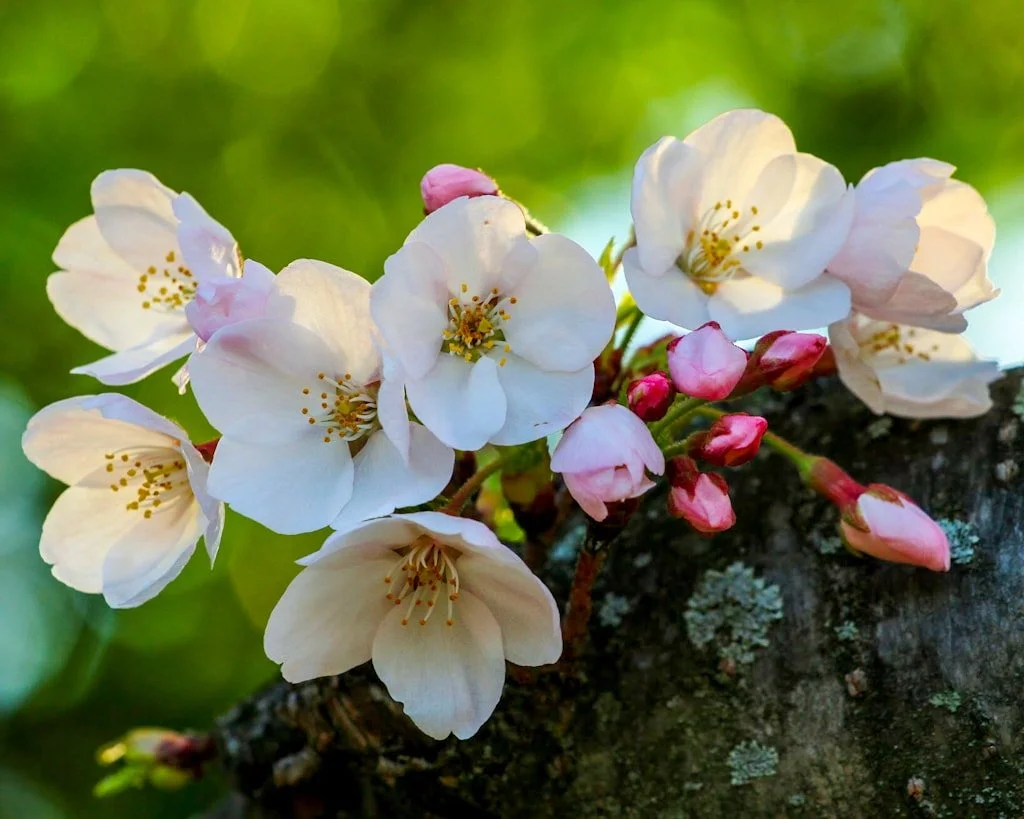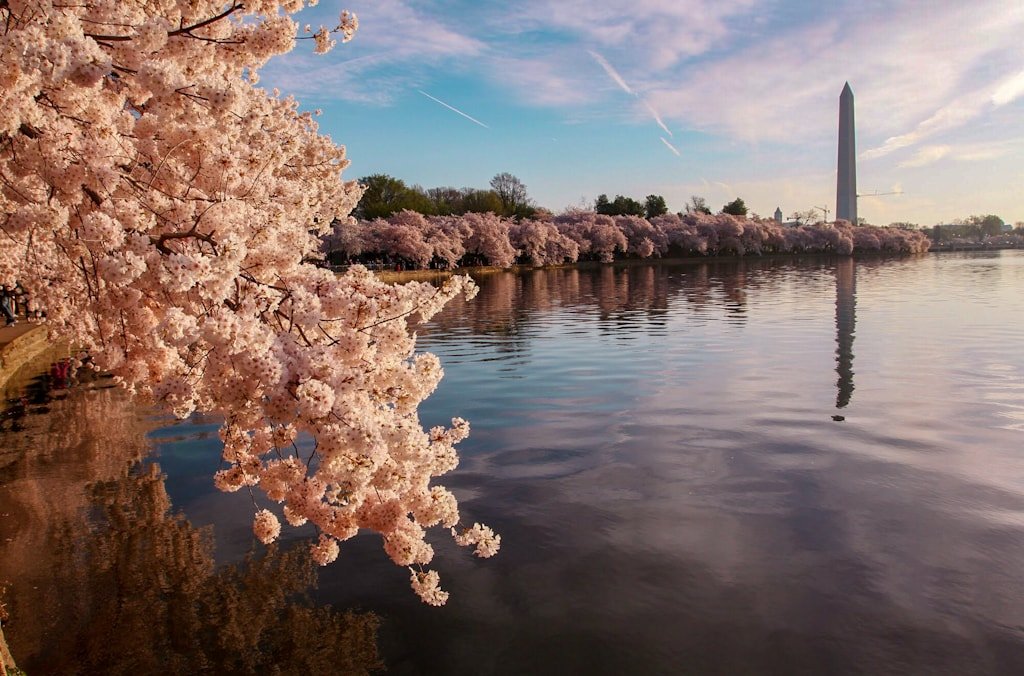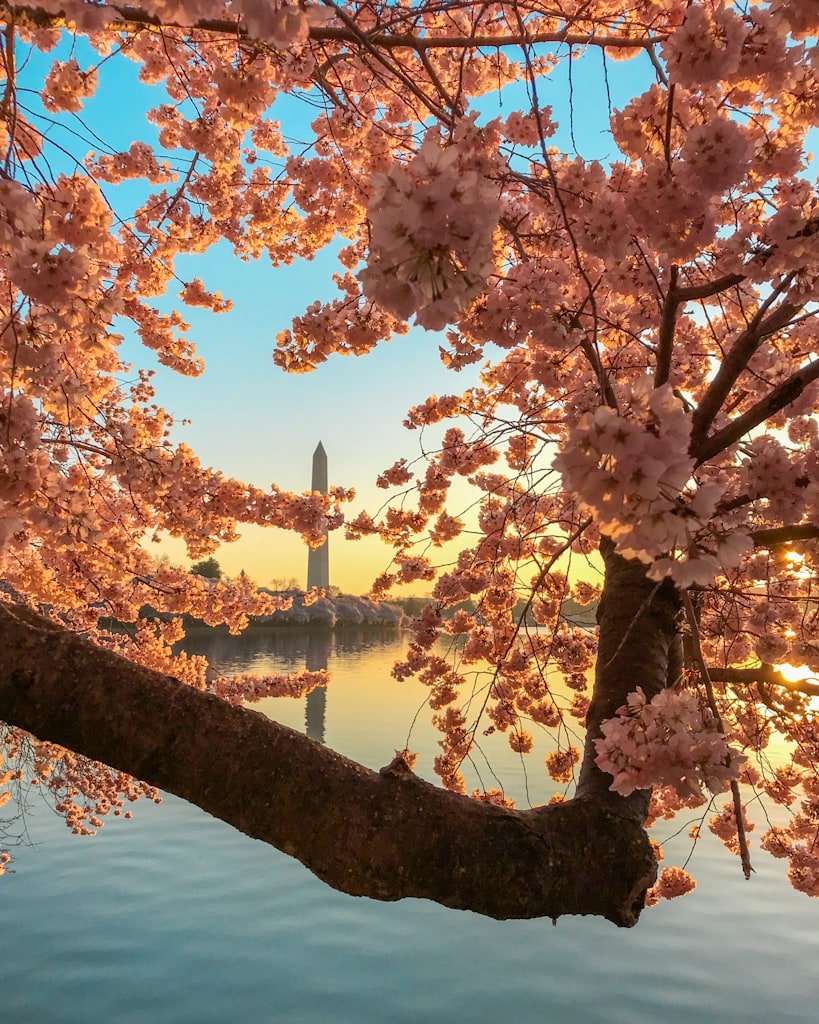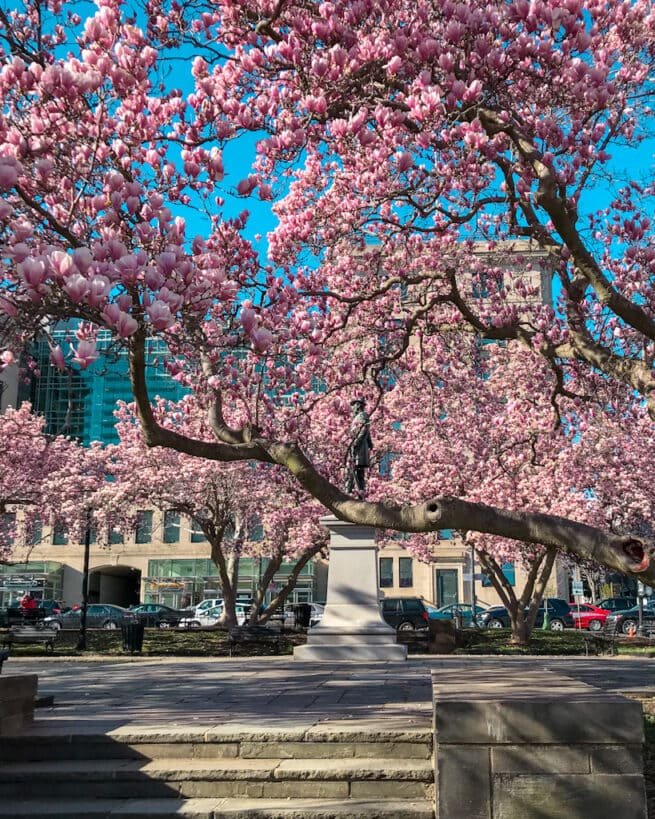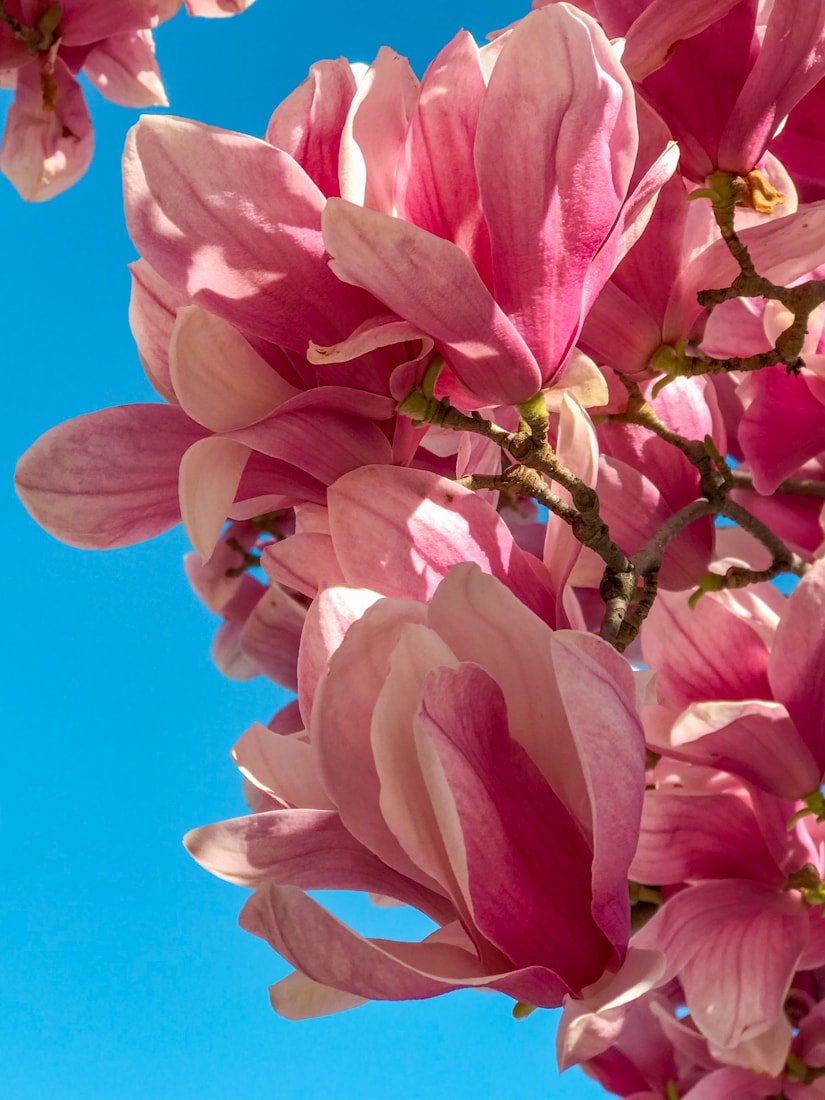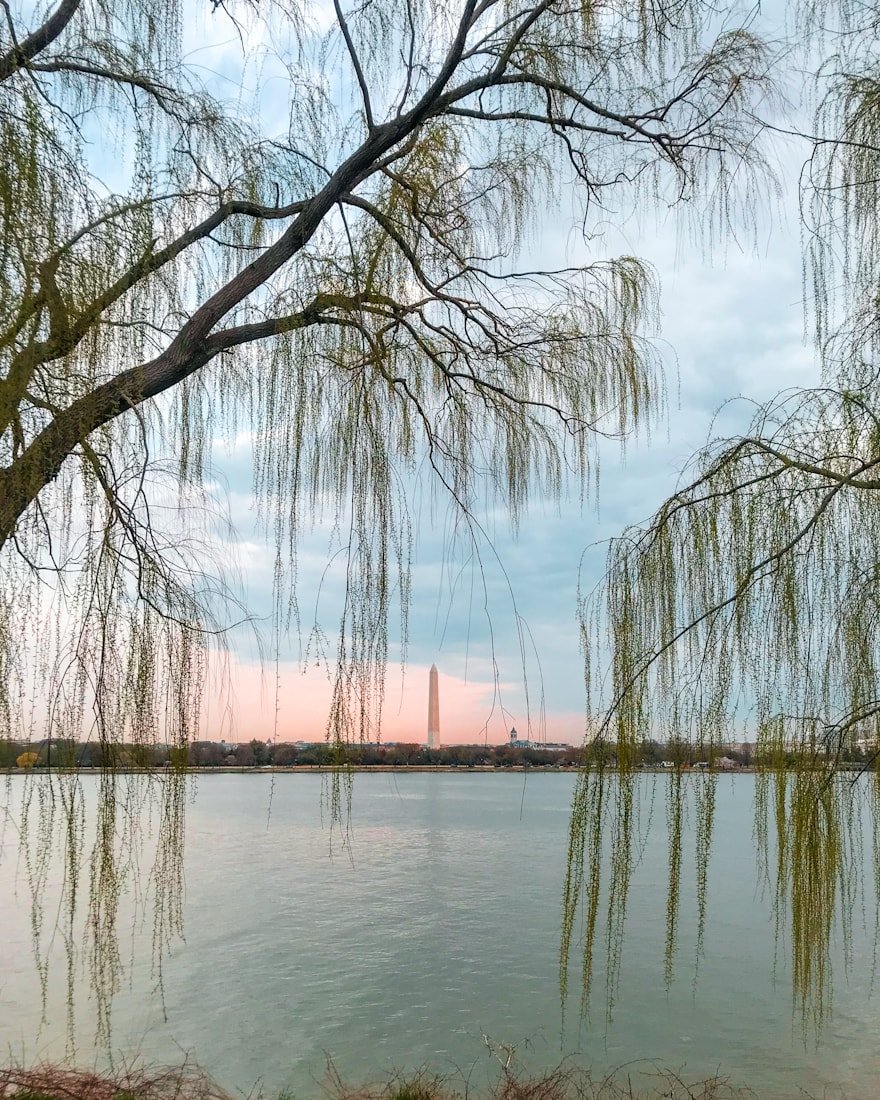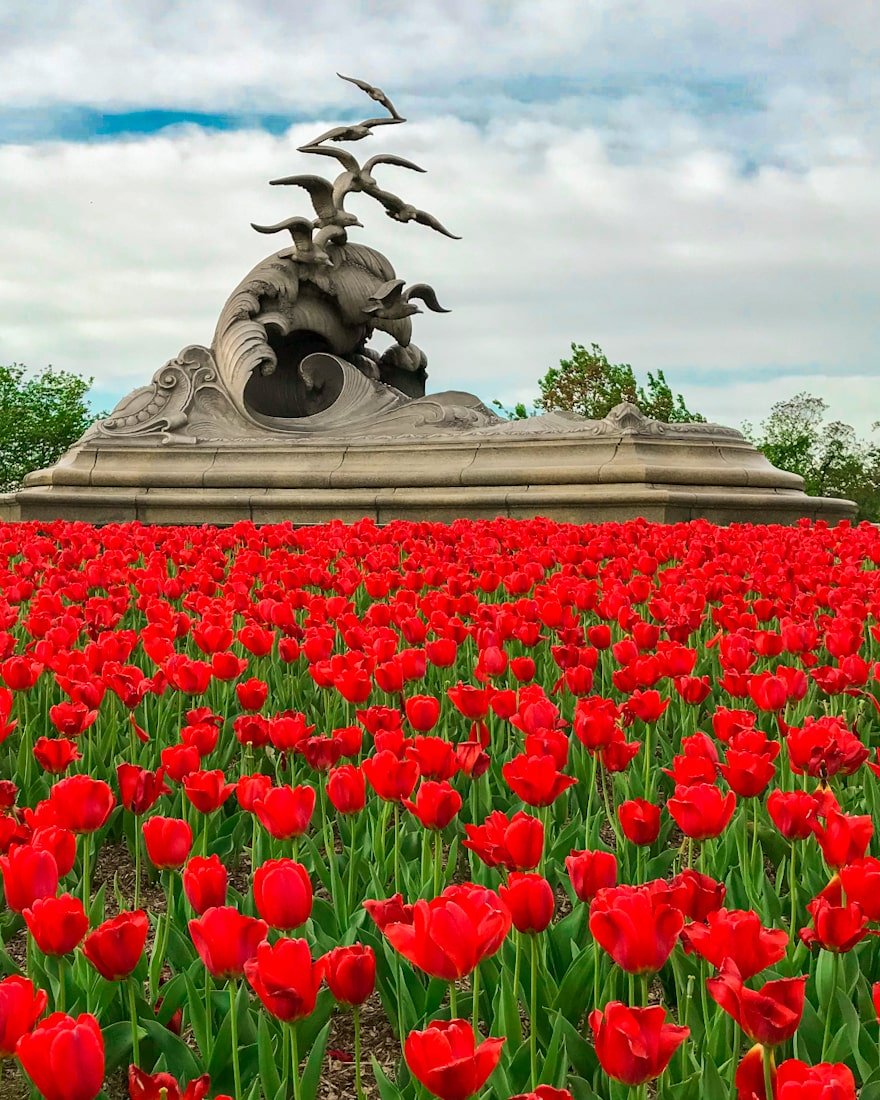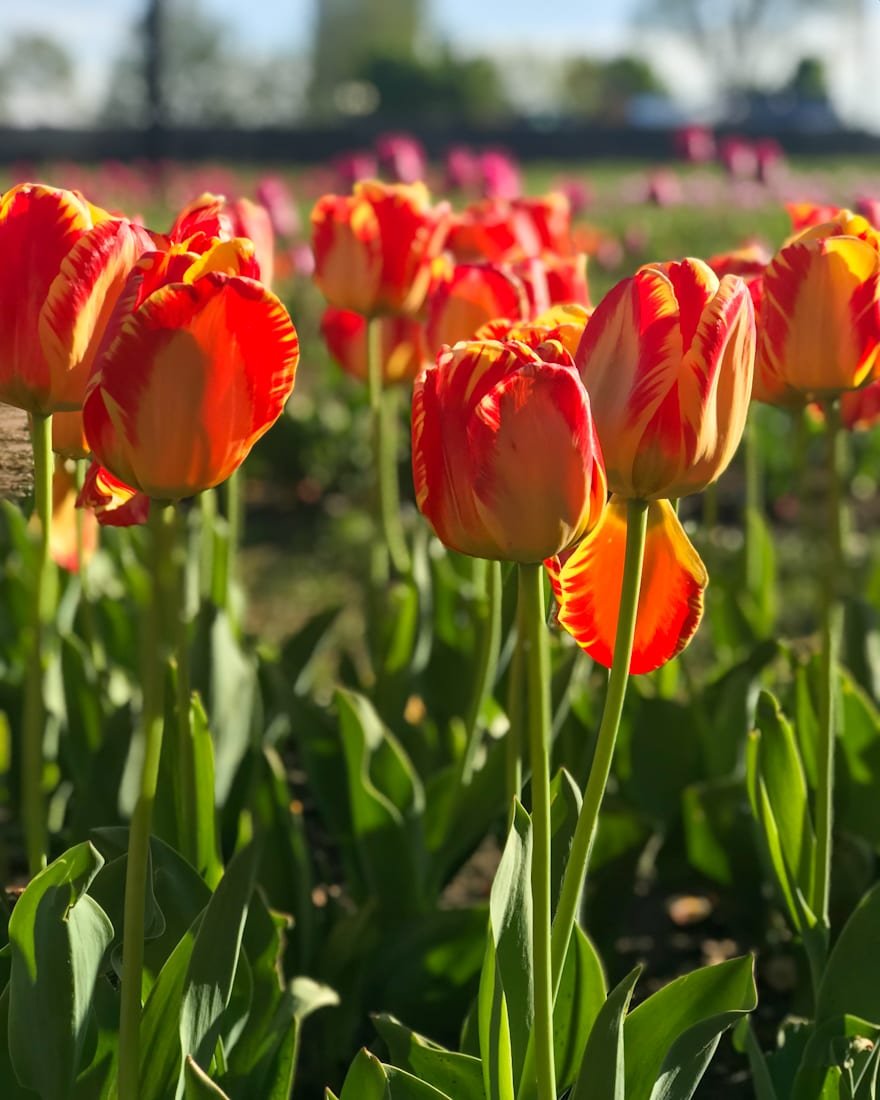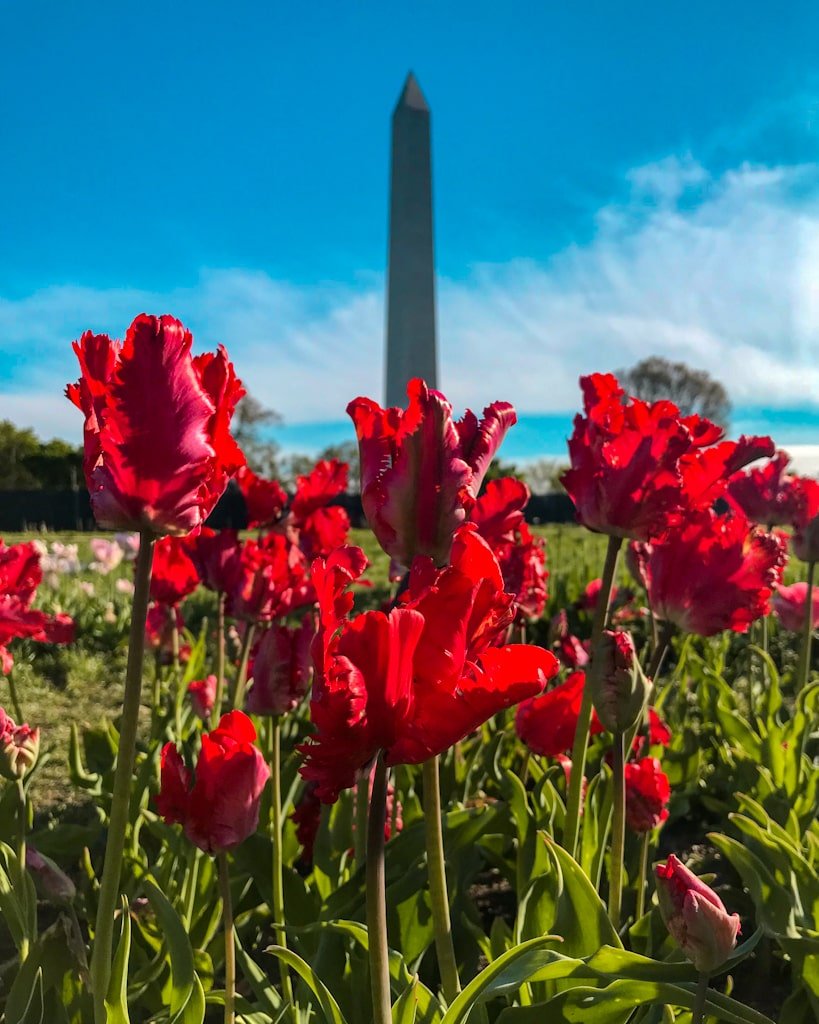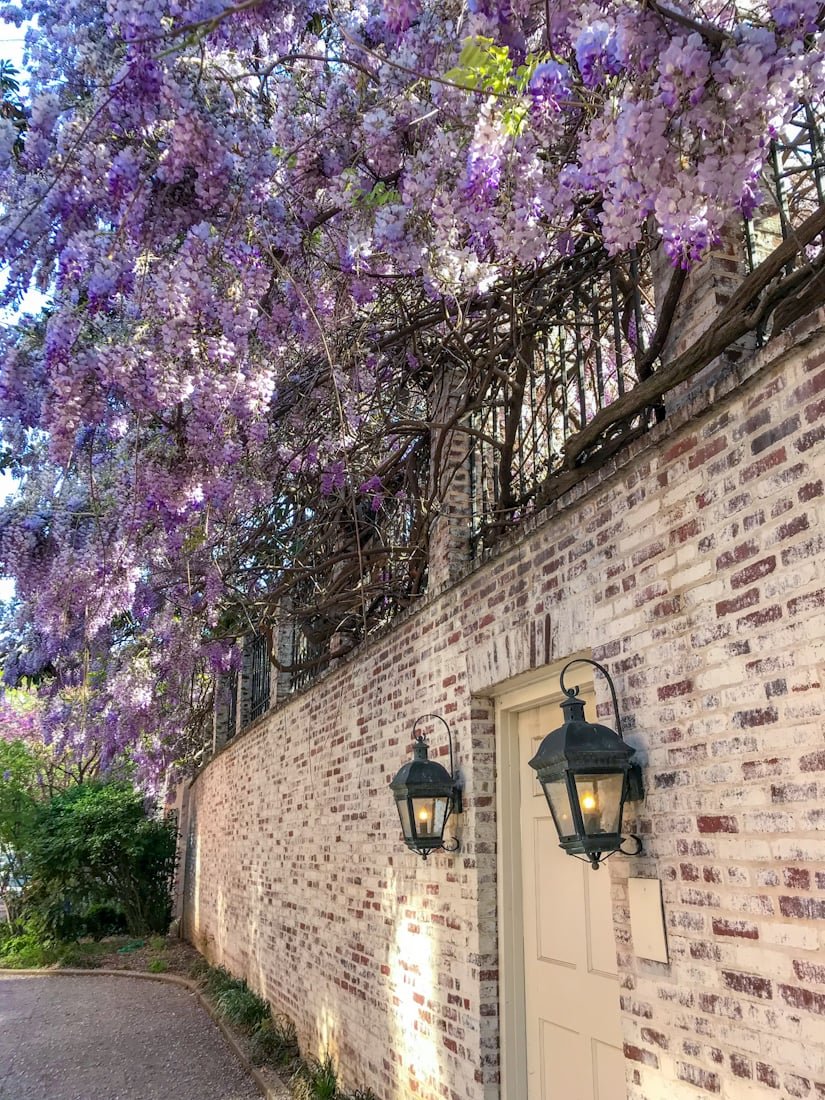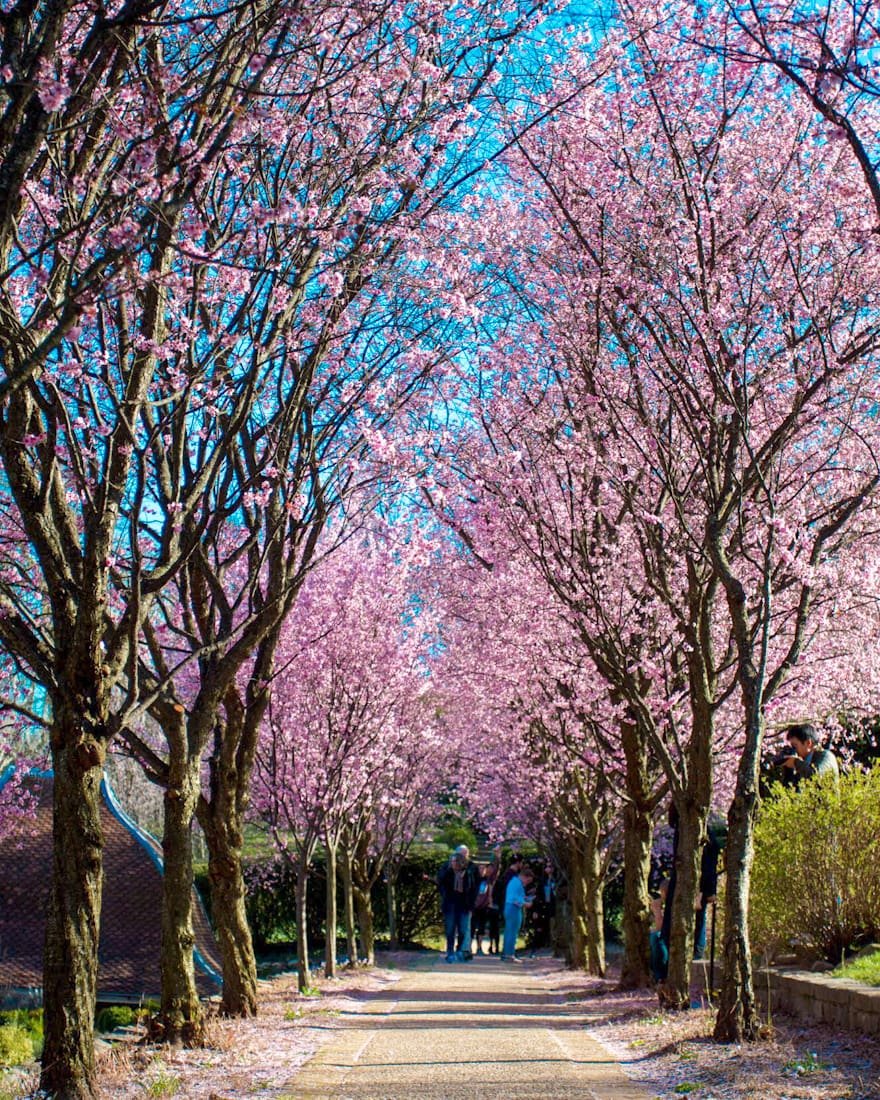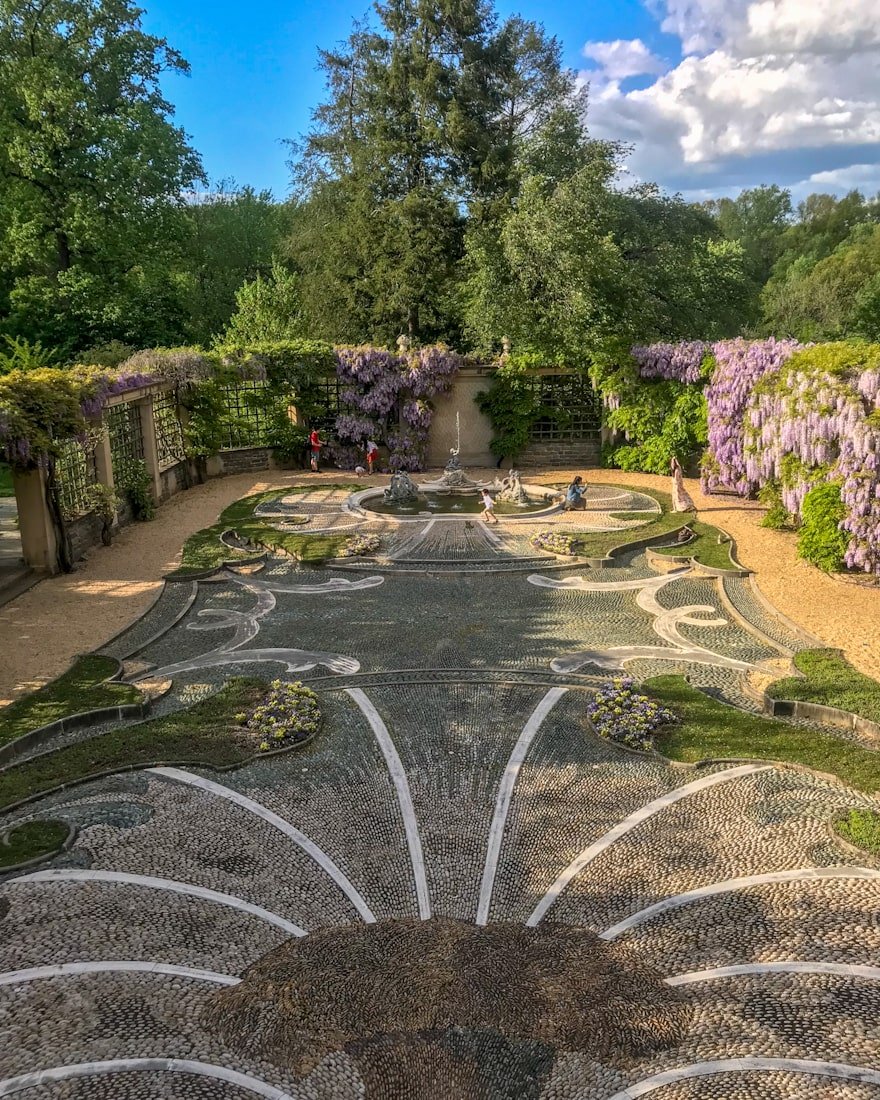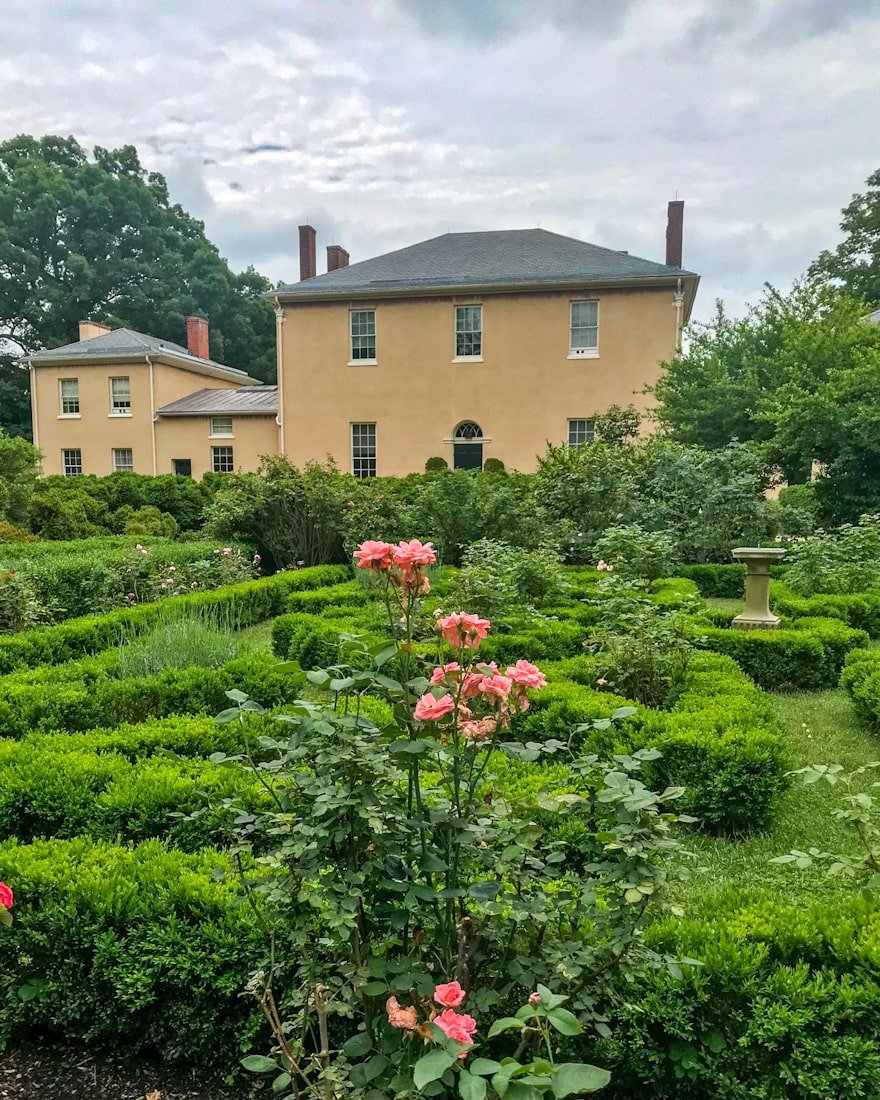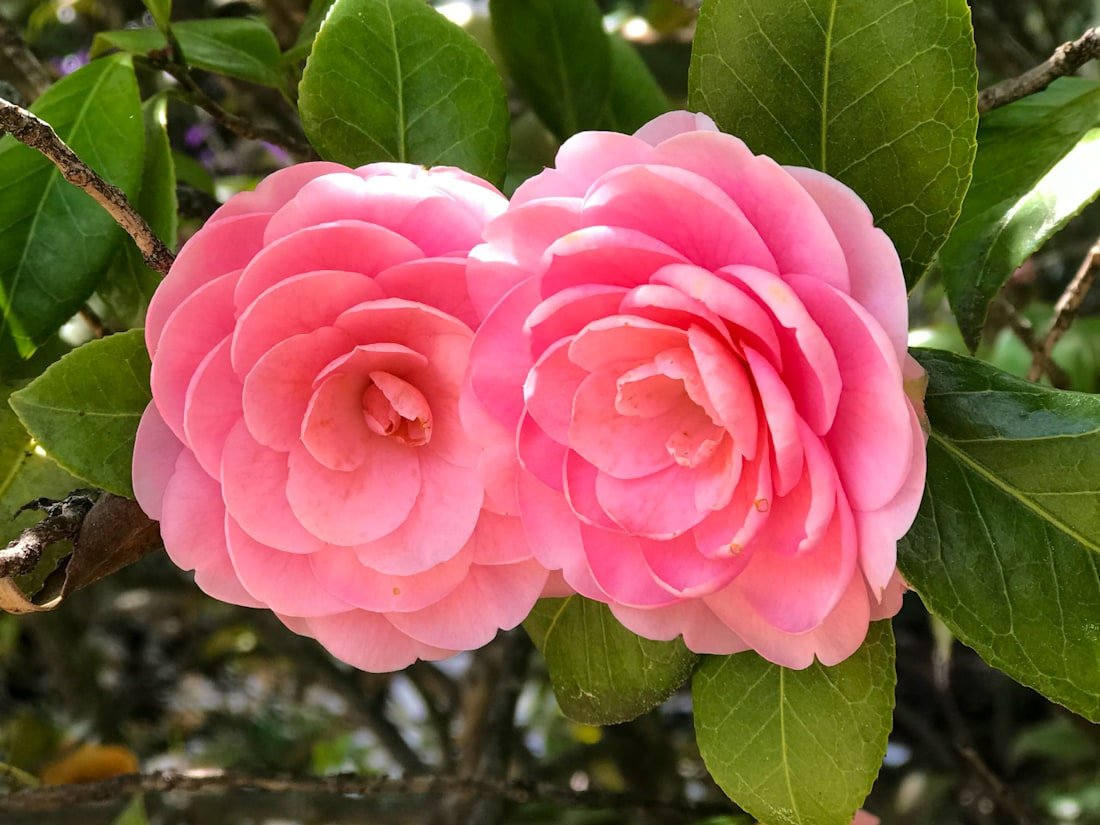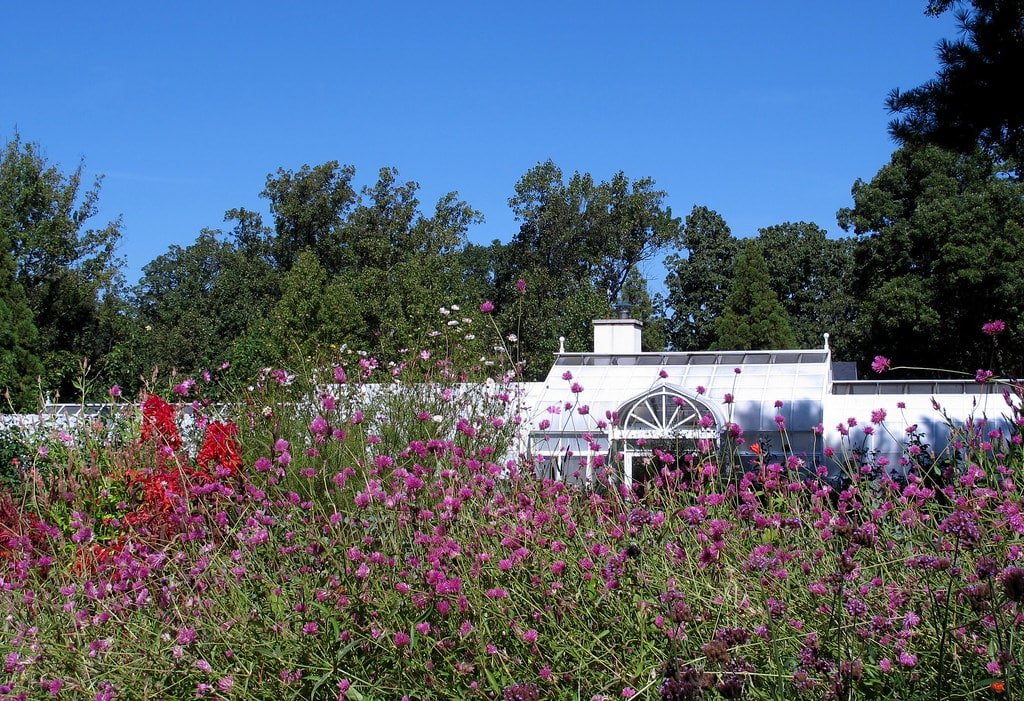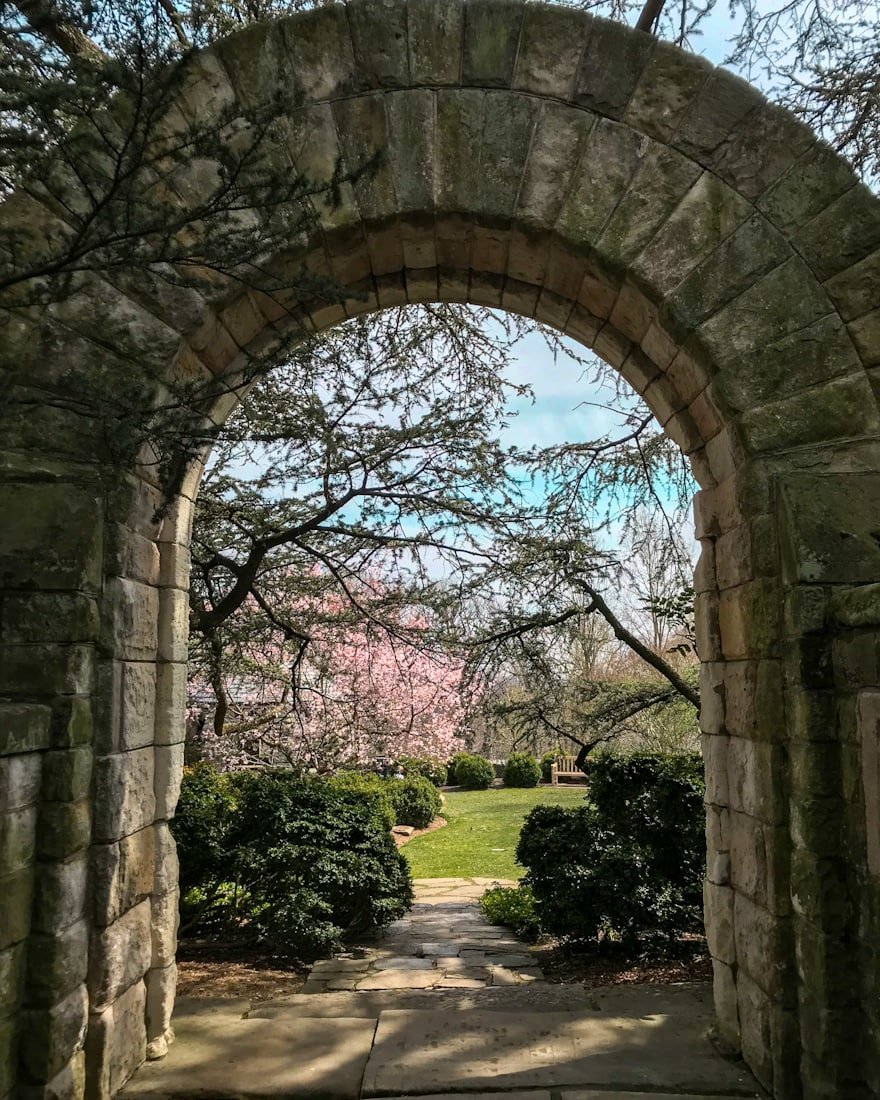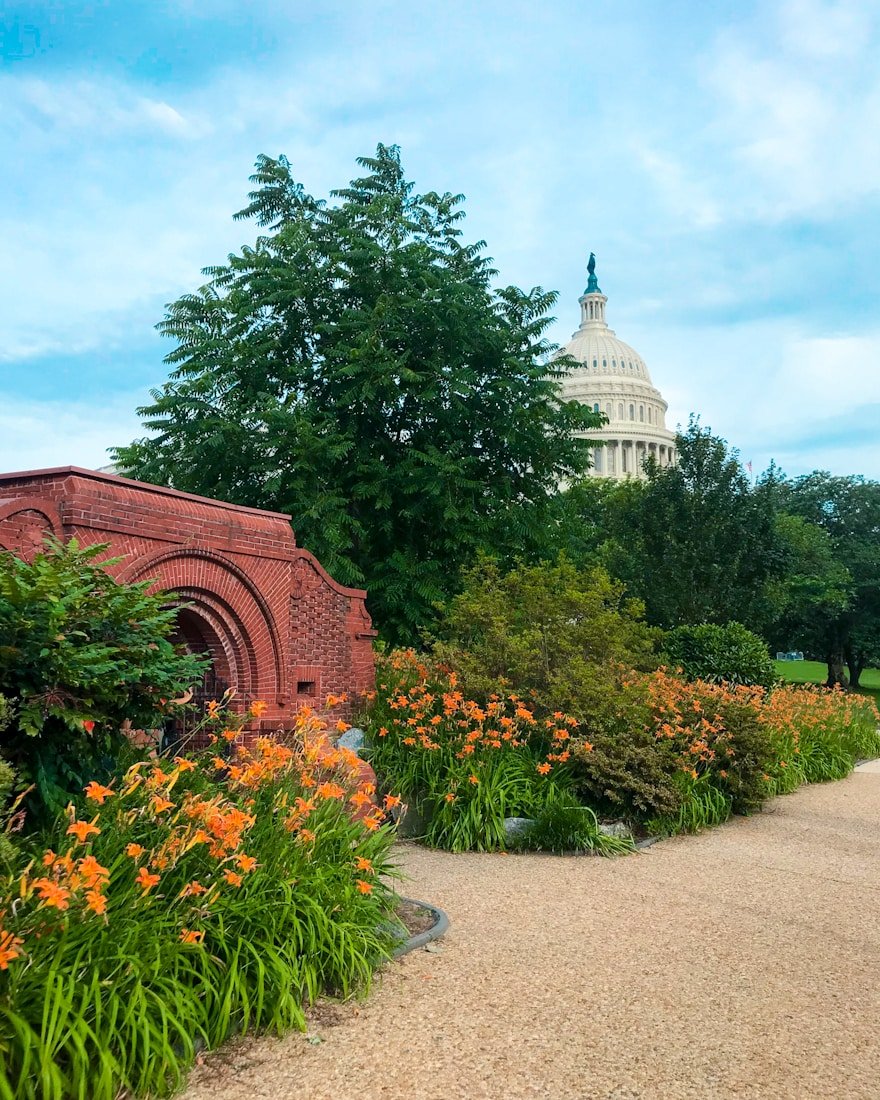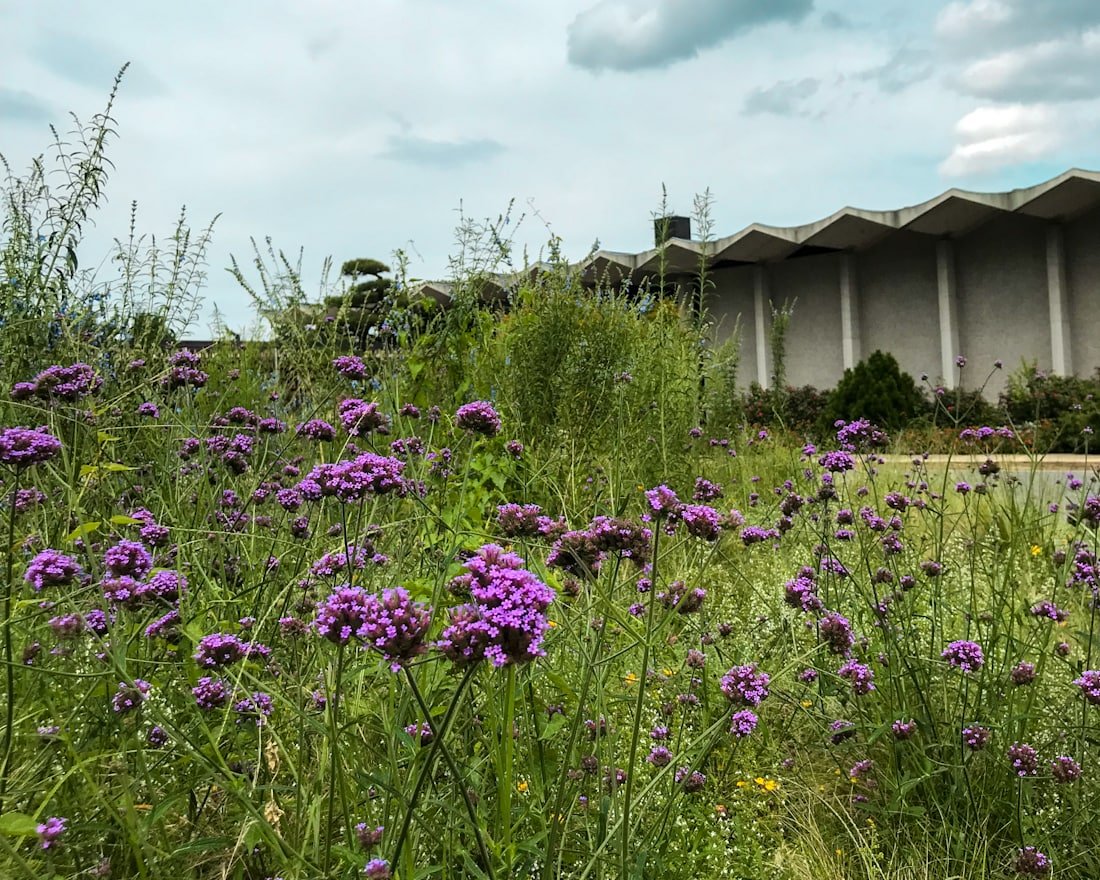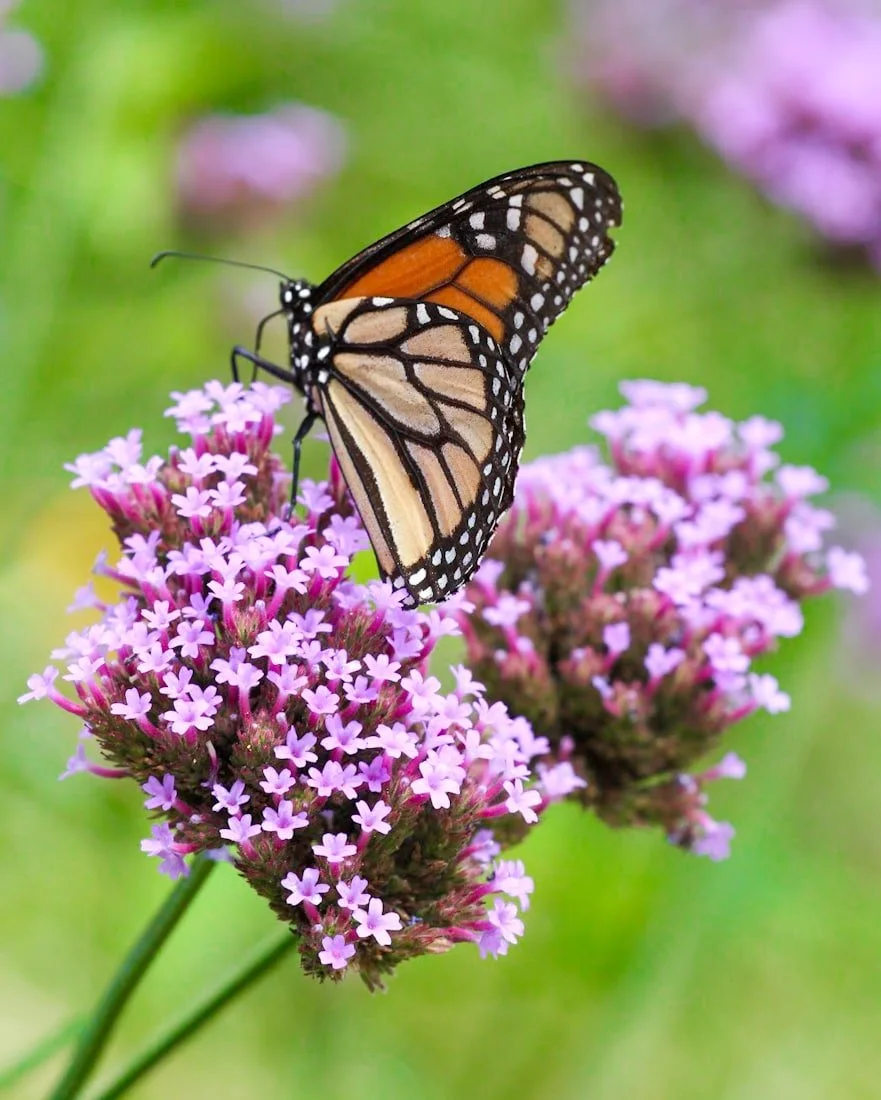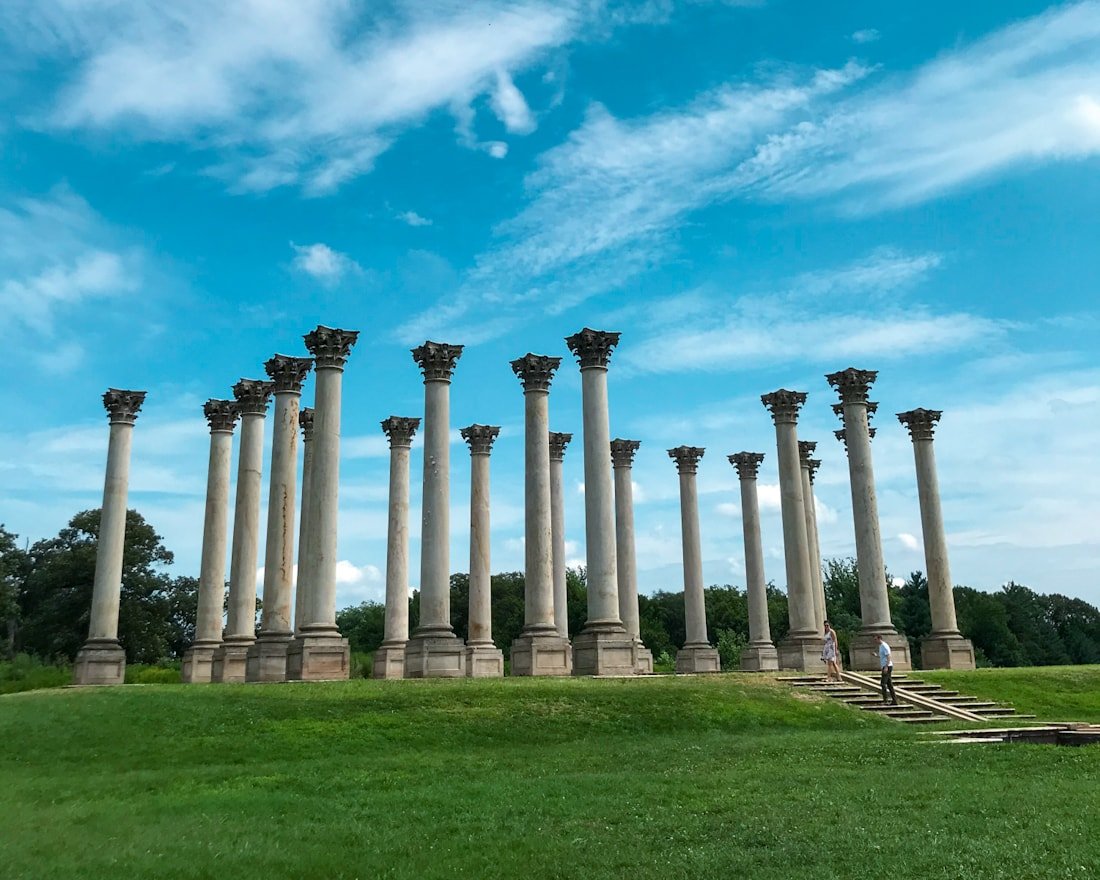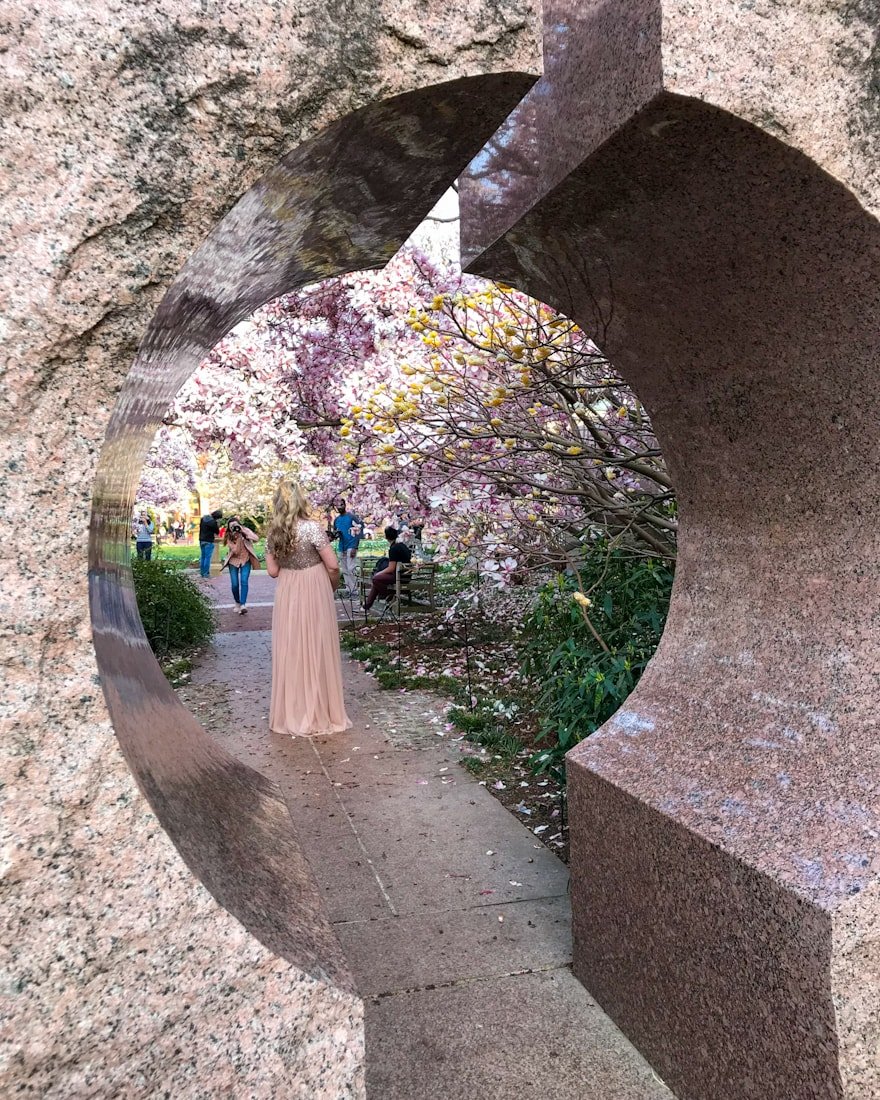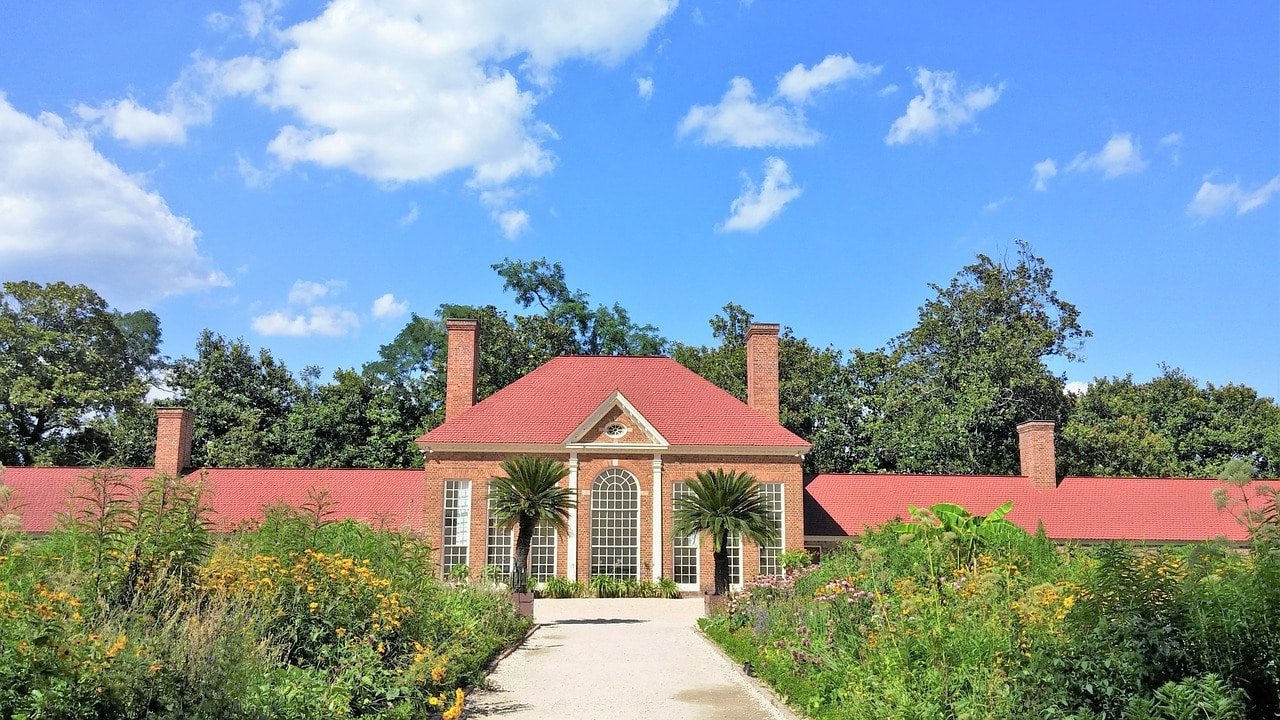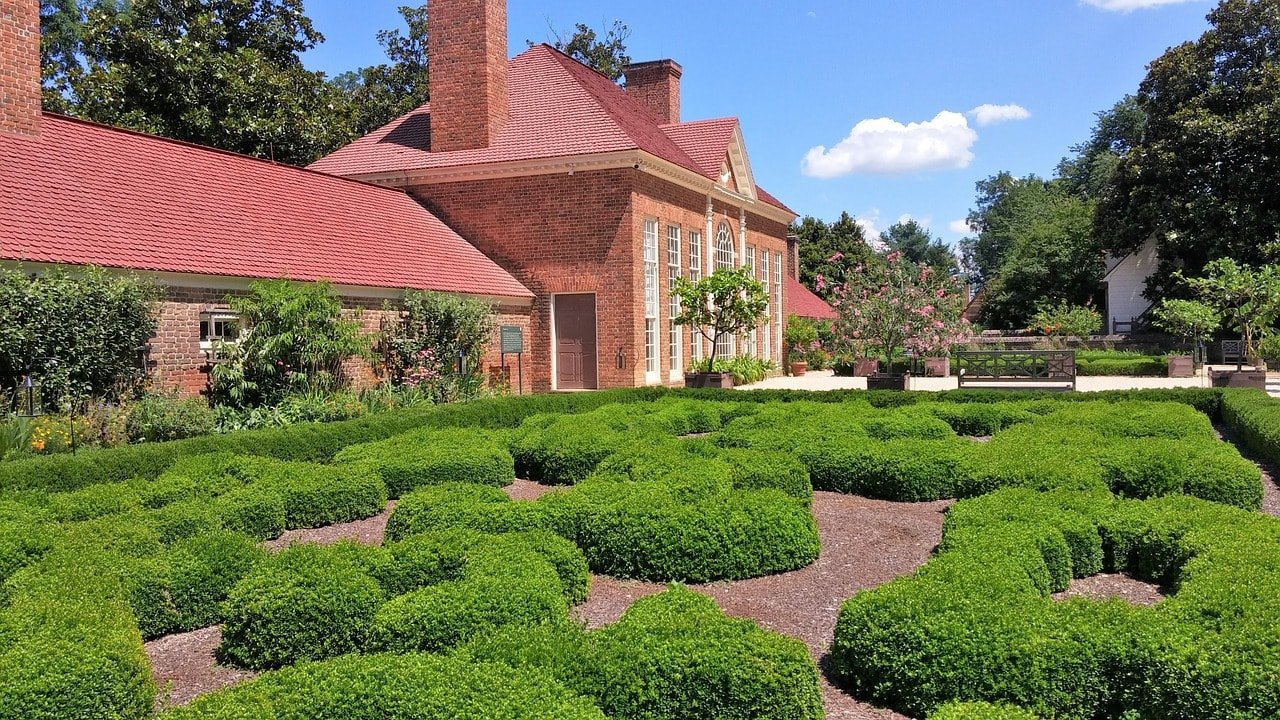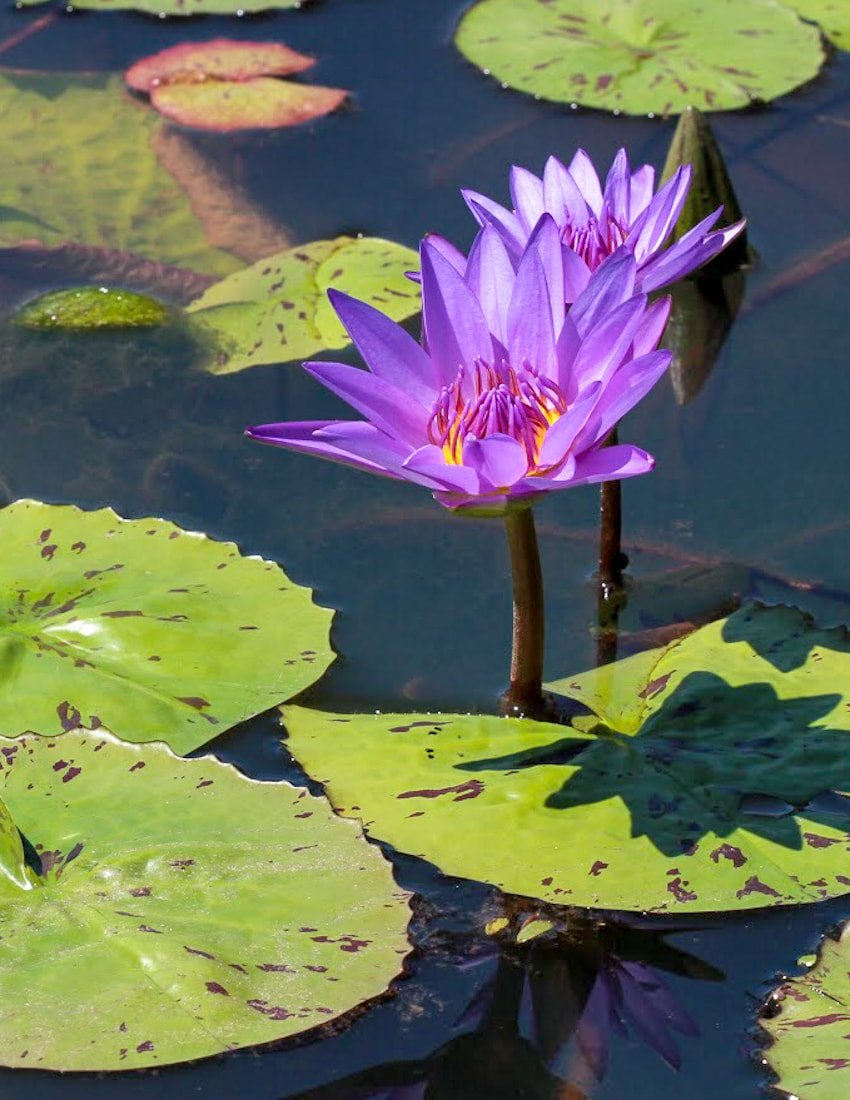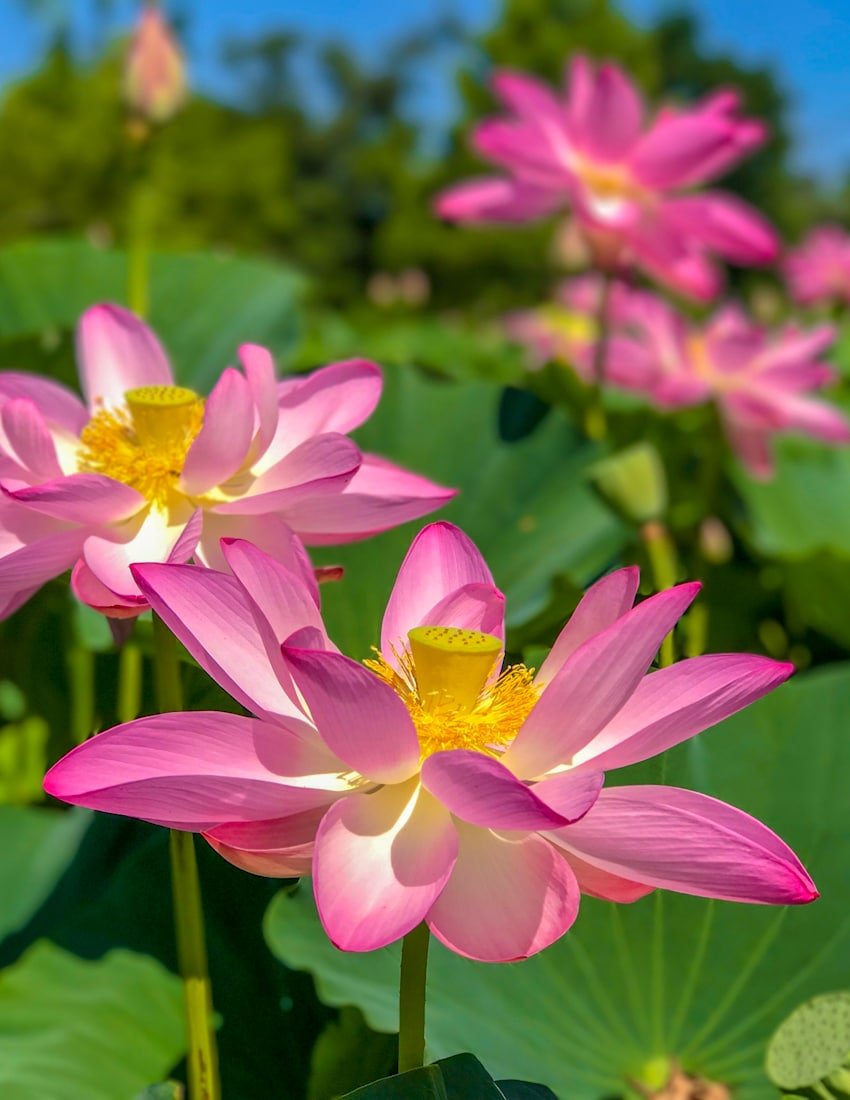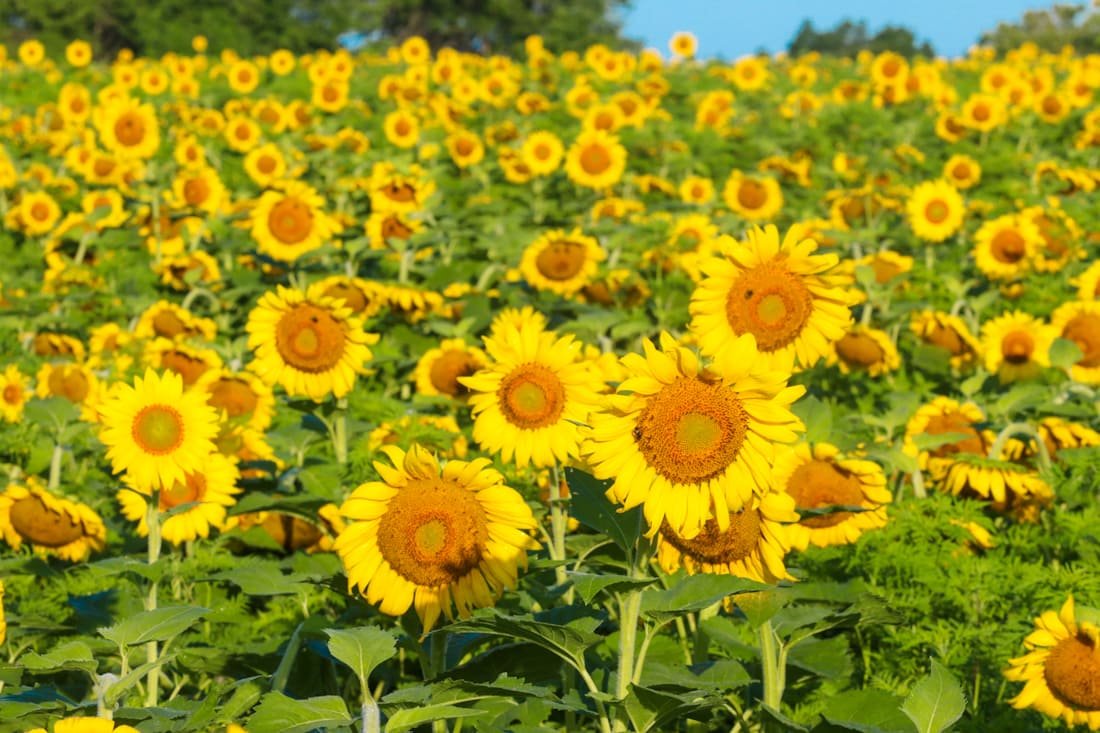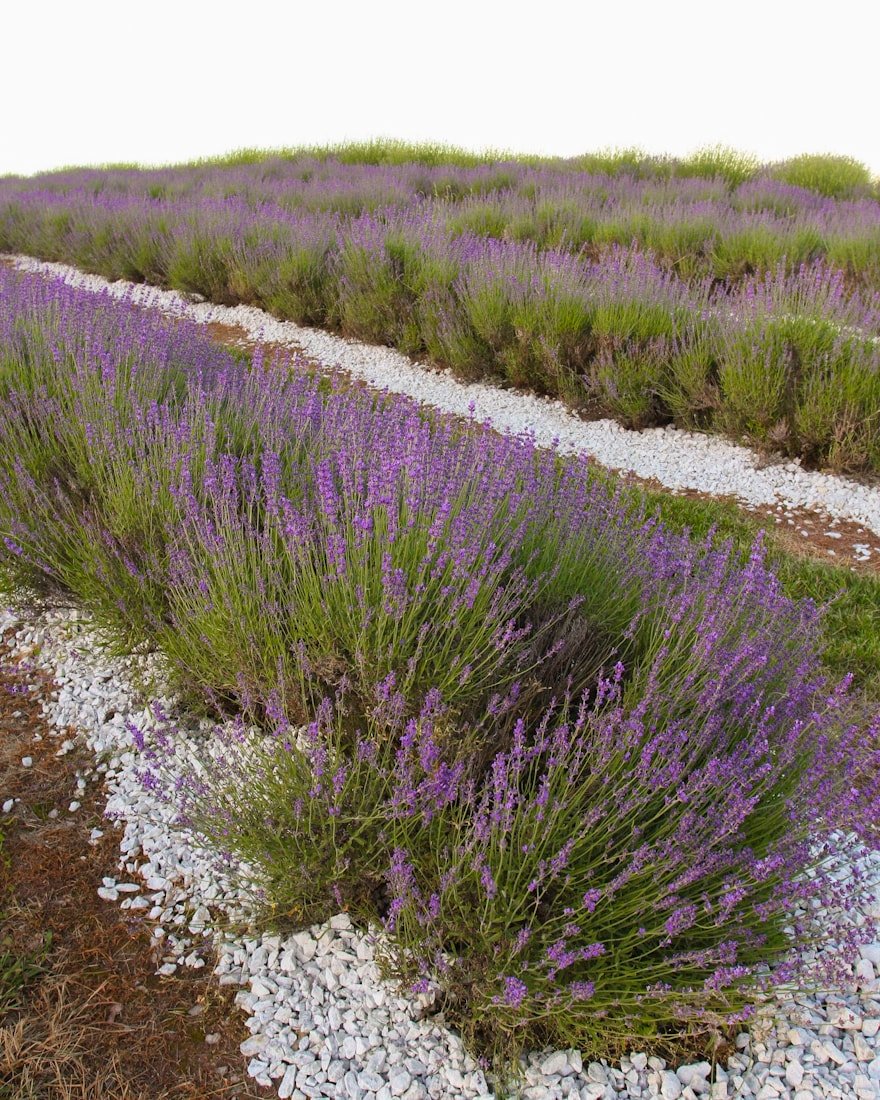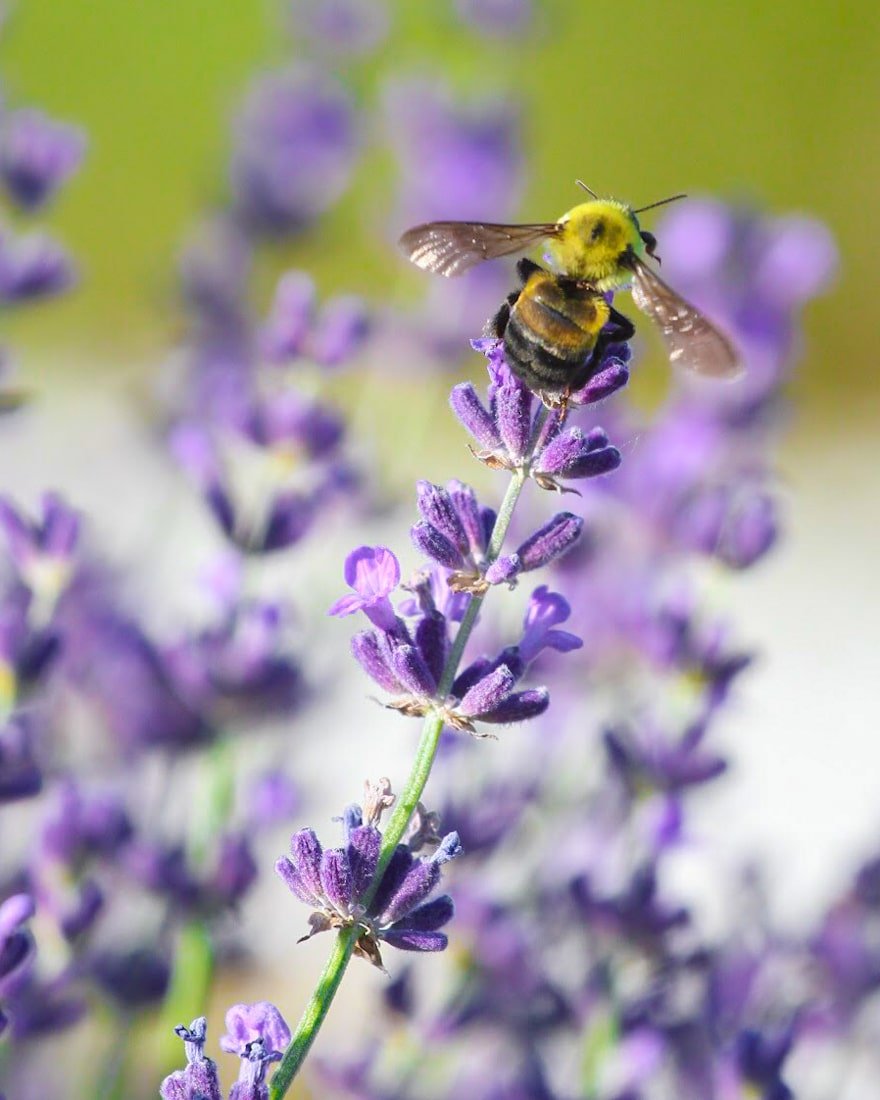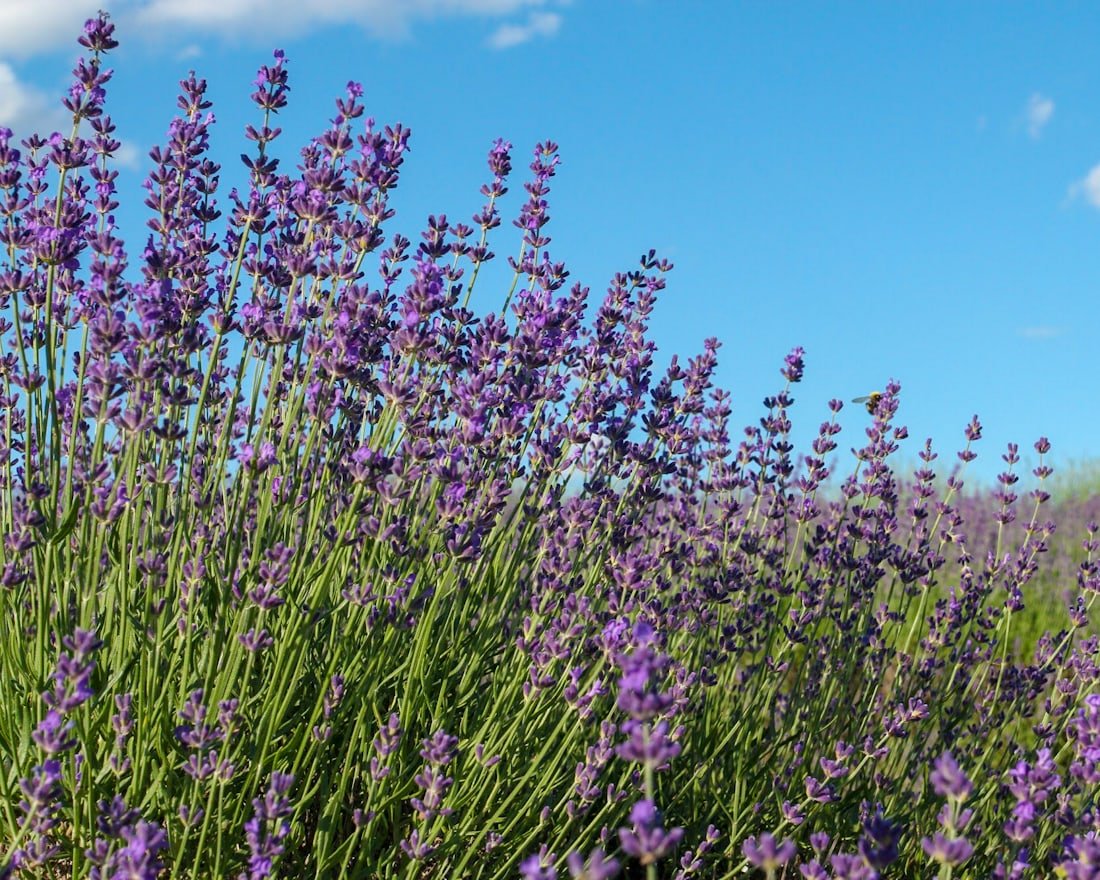The housing market around here might be in bloom year round, but these flowers aren't. Take an afternoon off and go explore the DMV for some beautiful blooms while they're still here!
Early Spring Blooming Washington, DC Gardens
These DC parks and gardens bloom from March through April with gorgeous flowering trees, bulbs and other spring blossoms.
Tidal Basin
Located in Washington DC’s West Potomac Park, the Tidal Basin is a partially man-made reservoir with more than 3,000 cherry trees. A 2-mile paved loop trail around the basin connects several monuments including the Jefferson Memorial, Franklin Delano Roosevelt Memorial, and Martin Luther King Memorial. The basin also has views of the Washington Monument.
The Tidal Basin is the best place in Washington DC to see cherry blossoms. Check out my full guide to seeing cherry blossoms in DC here, with tons of tips on planning a visit and finding the cherry best blossom locations.
Blossoms to see: Yoshino and Kwanzan cherry | Approximate dates: Late March to mid-April
NPS: Tidal Basin | 1501 Maine Ave SW, Washington, DC 20024
Rawlins Park
Rawlins Park is one of the earliest-blooming spots in the city. It’s located in Washington DC’s Foggy Bottom neighborhood a few blocks from the National Mall and White House. The park spans an entire city block, with fountains in summer, benches for relaxing and a statue of Civil War General John A. Rawlins at the eastern end. But in early spring, the saucer magnolia trees that line the park bloom in a riot of pink.
Blossoms to see: Magnolias | Approximate dates: mid to late March
1900 E St NW, Washington, DC 20415
Lady Bird Johnson Park
This park is on Columbia Island, a man-made island that is part of Washington, DC. Confusingly, it’s actually located on the Virginia side of the Potomac River across from the Tidal Basin. Lady Bird Johnson Park has lovely views of the monuments of Washington, DC, making it a beautiful spot for a spring walk. The Mount Vernon Trail passes through the park along its miles of biking and running trails. In spring, early daffodils bloom in large clusters as well as a few weeping cherry trees. Tulips and dogwoods bloom in late spring [see below].
This park can be difficult to get to. By car, the only way to reach it is on the George Washington Parkway Southbound, by parking at the Columbia Island Marina here. A paved trail leads from the parking lot, through a tunnel under the parkway, to the Potomac River side of the park. By foot or bicycle, you can reach it along the Mount Vernon Trail.
Blossoms to see: Daffodils, cherry trees | Approximate dates: mid to late March
Lady Bird Johnson Park | Washington Blvd, Washington, DC 20037
Mid to Late Spring DC Gardens & Blossom Spots
Navy – Merchant Marine Memorial
The Merchant Marine Memorial is located on Columbia Island, within Lady Bird Johnson Park. In mid to late spring, a sea of red tulips surrounds the memorial with blooms. A number of dogwood trees also bloom. For information on spring blooms as well as how to get here, see the Lady Bird Johnson Park listing above.
Floral Library
This small garden is in DC on the National Mall, tucked between the Tidal Basin parking area and Independence Drive. Established in 1969 as part of Lady Bird Johnson’s Capital Beautification Project, the Floral Library has flower beds maintained by the National Park Service. In April, it blooms with a “library” of tulips. Some years, annual flowers are planted here after the tulips bloom.
Blossoms to see: Nearly 100 varieties of tulips | Approximate dates: Early April
Quality Hill in Georgetown
Quality Hill is a private home in the Georgetown neighborhood of Washington, DC. It’s also known as the John Thomson Mason house after an early owner, the nephew of George Mason. Quality Hill has purple wisteria that blooms each spring, which is especially beautiful against the whitewashed brick facade. This one is just an Instagram spot – you can’t actually tour the garden – but it’s still worth a stop if you’re visiting other gardens in Georgetown.
Blossoms to see: Wisteria | Approximate dates: late April
3425 Prospect St NW, Washington, DC 20007
Planning a DC trip and need ideas on where to stay? Get my guide to the best Washington DC Airbnbs by neighborhood.
Spring & Summer Blooming Washington, DC Gardens
These beautiful Washington, DC area gardens bloom in both the spring and summer seasons.
Dumbarton Oaks
Dumbarton Oaks is a historic estate in the Georgetown neighborhood of Washington, DC. It’s also home to a research library and collection, which was gifted to Harvard University in 1940. The Dumbarton Oaks garden is the result of nearly 30 years’ collaboration between the former owners, Robert Woods Bliss and Mildred Barnes Bliss, with landscape designer Beatrix Farrand. Together Margaret and Beatrix created a series of terraced garden rooms and vistas. If you go in spring, be sure to wander the neighboring Georgetown streets to see more wisteria, dogwood and tulips in bloom. This is one of my favorite spots in the city!
Blossoms to see: Magnolia, forsythia, flowering cherry and plum, tulips, wisteria and lilac in spring; roses and other annuals and perennials in summer. Note: The garden is only open in the afternoons.
Dumbarton Oaks | 3120 R St NW, Washington, DC 20007
Tudor Place
Tudor Place is a Federal-style mansion in the Georgetown neighborhood of Washington, DC, just a block from Dumbarton Oaks. It was originally the home of Martha Parke Custis Peter, a granddaughter of Martha Washington. Tudor Place remained in the same family for six generations, and is now a museum and national historic landmark. You need to register for house tours ahead of time, but the garden can be explored during opening hours for free; stop in the visitor center for a map and audio guide.
Blossoms to see: Magnolia, flowering cherry, camellia, azaleas, Florentine tulips in spring; roses, lilies and other perennials in summer.
Tudor Place | 1644 31st St NW, Washington, DC 20007
Hillwood Estate, Museum, and Gardens
Hillwood is a museum and gardens in Northwest Washington, DC. It’s the former residence of businesswoman, socialite, philanthropist and collector Marjorie Merriweather Post. Hillwood is known for her large decorative arts collection from imperial Russia as well as cultivated orchids. You can tour the house and grounds, which include a rose garden, Japanese garden and a formal French parterre garden.
Blossoms to see: Magnolia, cherry, tulips, azaleas, dogwoods, camellias, wisteria and others in spring; rhododendron, roses, crepe myrtle, annuals and perennials in summer; plus chrysanthemums in fall and pansies in winter.
Images: Hillwood Museum and Gardens
Hillwood Estate | 4155 Linnean Ave NW, Washington, DC 20008
Washington National Cathedral Bishop’s Garden
The original plan for the Washington National Cathedral included a Bishop’s Garden, which was updated by later landscape designers. It’s the most cultivated of the Cathedral gardens, which cover more than 39 acres. The garden’s landscape plan was designed to be suitable for a 14th century Gothic cathedral, with plants of historical interest, plants of the Bible and Christian legends, and native plants.
Blossoms to see: Magnolia, flowering cherry, hyacinth, tulips, iris in spring; perennials and herbs in summer.
National Cathedral Gardens | 3101 Wisconsin Ave NW, Washington, DC 20016
U.S. Capitol
The Capitol building is home to the United States Congress and a Washington, DC icon. Located at the end of the National Mall, its grounds are host to inaugurations and Independence Day celebrations, as well as seasonal flowers. From different vantage points around the Capitol building, photographers can capture shots of its dome framed by blossoms.
Blossoms to see: Magnolia, flowering cherry, pansies, tulips and azaleas in spring; day lilies around the Summerhouse fountains and annuals in other flower beds in summer.
U.S. Capitol | First St SE, Washington, DC 20004
United States National Arboretum
The National Arboretum is a spot that some lifelong DC residents don’t know about! Operated by the Department of Agriculture, the arboretum is just a few miles from the Capitol building and encompasses 446 acres of land. It’s most famous for spring azaleas, its bonsai collection, and the National Capitol Columns, which were relocated there after the Capitol building was expanded in 1958.
Blossoms to see: Magnolia, flowering cherry, dogwood and azalea in spring; annuals, perennials, herbs and wildflowers in summer.
National Arboretum | 3501 New York Ave NE, Washington, DC 20002
Enid A. Haupt Garden at the Smithsonian Castle
Enid A. Haupt Garden covers four acres between the Smithsonian Castle and Independence Avenue. Composed of the Parterre, the Moongate Garden, and the Fountain Garden, the Haupt Garden’s design brings together the cultures and architecture of the surrounding museums and buildings.
Blossoms to see: magnolias, flowering cherry, hyacinth, paperbush, tulips; more annuals and perennials in summer. The Enid Haupt Garden has blooms throughout the seasons, starting with magnolias in mid to late March.
Enid A. Haupt Garden | 1050 Independence Ave SW, Washington, DC 20560
Franciscan Monastery of the Holy Land in America
The Franciscan Monastery is a best-kept secret of DC! In late spring and summer, its grounds are full of beautiful flowers as well as shrines, roses and many native plants.
Blossoms to see: Flowering cherry, magnolia, azaleas and tulips in spring; roses, hydrangea, mountain laurel, and other perennials in summer.
Tour the Gardens of the Franciscan Monastery
Franciscan Monastery | 1400 Quincy St NE, Washington, DC 20017
Mount Vernon
Mount Vernon is the former plantation and home of George Washington and his wife Martha. The estate is situated on the banks of the Potomac River near Alexandria, Virginia, less than 15 minutes from Washington, DC.
George Washington oversaw the planting and care of his gardens and extensively redesigned them to be a simpler, more naturalistic style. Today, the gardens still grow vegetables and flowers, and are noted for southern magnolia, damask rose and boxwood. They bloom from spring through fall with bulbs and perennials. Find out about all of the Mount Vernon garden plants here.
Mount Vernon Gardens | 3200 Mount Vernon Hwy, Mt Vernon, VA 22121
Netherlands Carillon
The Netherlands Carillon was a gift to the United States from the people of the Netherlands in 1954, in thanks of aid during and after the second World War.
The carillon is located in a park in Arlington, Virginia, near the Marine Corps memorial. It has expansive views of Washington, DC and monuments, and is a great spot for photos, especially at sunrise. In spring, thousands of tulips bloom.
Blossoms to see: Tulips, annuals and perennials | Approximate dates: early April – summer
Netherlands Carillon | Location
Summer Blooming Gardens in the DC Area
These gorgeous Washington, DC area gardens bloom primarily in summer, but they really pack a punch!
Kenilworth Park & Aquatic Gardens
Kenilworth Aquatic Gardens is a National Park Service site located in the Northeast corner of Washington, DC. Nestled near the banks of the Anacostia River, Kenilworth Park & Aquatic Gardens preserves rare waterlilies and lotuses in large cultivated ponds. The park also contains the Kenilworth Marsh, the only remaining tidal marsh in Washington, DC.
Blossoms to see: Lotus and many varieties of water lilies in mid-summer. A Lotus & Waterlily Festival is typically held in mid-July at the start of the lotus season.
Kenilworth Aquatic Gardens | 1550 Anacostia Ave NE, Washington, DC 20019
McKee-Beshers Wildlife Management Area
McKee-Beshers Wildlife Management Area is located about 45 minutes outside Washington, D.C. in Poolesville, Maryland. It is a large forest between the Potomac River and the Chesapeake & Ohio Canal to the south, and Seneca Creek State Park to the east. Acres of sunflowers are planted each year at McKee-Beshers WMA to attract game birds. Every July, these spectacular fields in full bloom also draw photographers, garden enthusiasts, and tourists.
Blossoms to see: Sunflowers in mid- to late July.
McKee-Beshers WMA | 16898-16500 River Rd, Poolesville, MD 20837
Springfield Manor
Springfield Manor is a winery, distillery and farm that has a lavender festival in mid-June and mid-September, when their lavender crops reach peak bloom. Their their winery and brewery is open Friday evenings, Saturdays and Sundays, and it’s a nice weekend outing to see the lavender and stay for a light meal and drinks on their terrace.
Springfield Manor | 11836 Auburn Rd, Thurmont, MD 21788
Year-Round Washington, DC Gardens
United States Botanic Garden
The United States Botanical Garden (USBG) is located on the grounds of the Capitol building in Washington, D.C. It’s open every day of the year, including federal holidays, and is the oldest continually operating botanic garden in the United States. Its collections and gardens include orchids, rainforest flora, desert cactus and plants, and rare and endangered plants.
Blossoms to see: In addition to its year-round indoor collections, its seasonal gardens include aquatic plants, rose gardens and butterfly gardens that also draw hummingbirds. The Botanic Garden’s holiday display is also very popular each winter.



